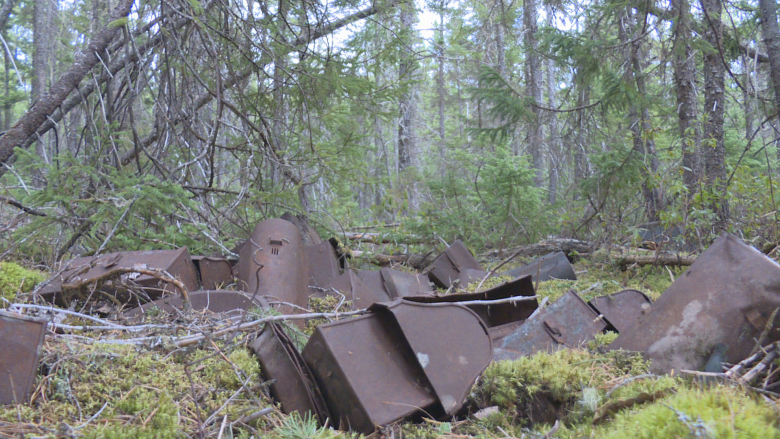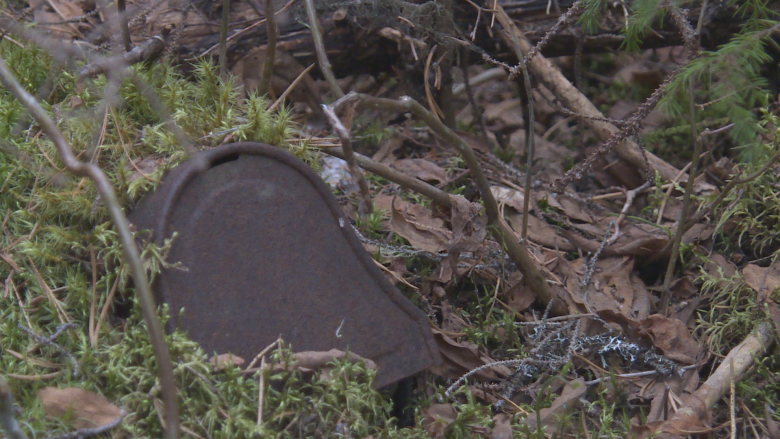Bear house? Lumber camp? Experts ponder origins of N.B.'s 'lunch box graveyard'
I was on a canoe trip with friends over the May long weekend, poking around our campsite along the Nepisiguit River deep in the northern New Brunswick wilderness, when one of us stumbled on the eerie sight now dubbed "the lunch box graveyard."
Piled high in a small forest glen between Popple Depot and Indian Falls Depot, more than 100 kilometres from the nearest town, is an incongruous jumble of rusted and decaying lunch boxes. They've clearly been there for decades, so old there's moss growing out of their leather handles.
My friend Sam Charters, an avid oudoorsman, placed one in his canoe while we completed our trip. Three days later I returned in a CBC vehicle.
The drive back along the Nepisiguit to our campsite is close to two hours on gravel roads, with the occasional washout. There's no cellphone signal and I'm much more likely to see a moose than a person.
When I start to document the "graveyard," I become very aware of the utter isolation. Every rustle of the surrounding woods is magnified, every snap of a branch turning into an echoing "crack."
Digging up a pair of lunch boxes to take back to researchers, I make another discovery. Buried beneath the first lunch box I pick up are four more. I had first counted more than 100, but how many more have been swallowed up by the moist, mossy forest floor, I'll never know.
I bring two lunch boxes back with me. One still has a tin cup inside its rotted shell. Their earthy, muddy, smell lingers inside my vehicle for weeks after.
Expert opinion
I take the lunch boxes to the New Brunswick Museum Archives and Research Library in Saint John. Gary Hughes is the curator of history there, an expert in all things old and ancient in New Brunswick.
He responds immediately to their shape.
"This is a familiar form that lasted from the late part of the 19th century, well into the 20th century," he says. "They would appear to be obsolete now with the later types of materials that we use to produce lunch boxes, but it was a tried and true method. And to have these in profusion in a rural area of New Brunswick is quite fascinating."
Hughes estimates the lunch boxes were made between 1890 and 1940. He's much more certain about their purpose.
"An industry! No question, and from something that is now obsolete — both the lunch boxes and the industry," he says.
"And that scale of burial, there must be more under the ground, you're just looking at perhaps the tip of the iceberg."
With a rough timeframe, I can cross-reference the lunch boxes' age with the location of their discovery for more clues about their origin.
Joshua Green at the New Brunswick Provincial Archives gives me everything he is able to dig up about the area at that time.
"When we looked into the history of land usage right around that part of the Nepisiguit, we found that for a very long time, going back into the 19th century, there's a long history of timber leases," Green says. "And the more we dug, we found many, many references really two kinds of land use … which were sporting, including fishing along the river and different types of lumber camps and depots."
An abandoned lumber camp was an early and obvious guess, given New Brunswick's long history of logging in the area. But a single historic note related to the mass storage and transport of food does seem to tie in well with the lunch box graveyard.
"In the mid-1920s … there was a bear house located at that spot," Green says. "A bear house, or a bear camp, was just a log cabin or a small cabin constructed in the more remote places that were secured against bears, because the bears wanted to get the pork and beans and flour inside for the lumber camps."
It's the only possible answer we have that links large supplies of food in the area to these lunch boxes during those years. But both Grass and Hughes admit that, as it stands, a bear camp is the best theory.
A definitive answer to the question of who dumped the lunch boxes in the woods and why still eludes us.






